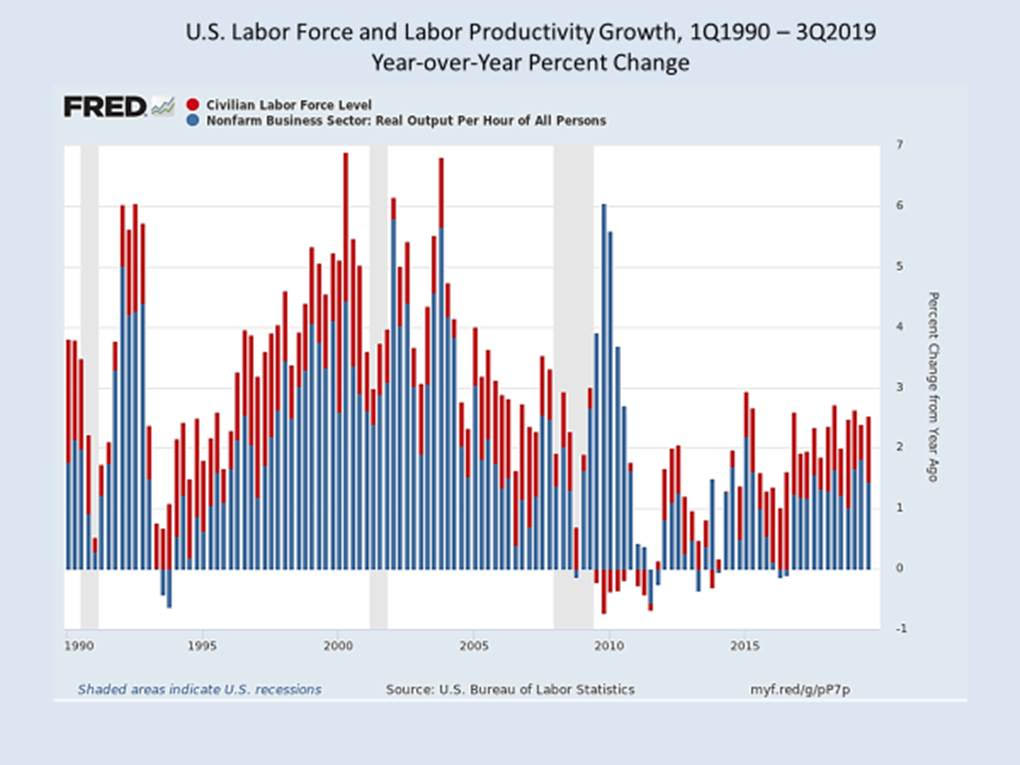With many presidential hopefuls promising loads of goodies to supporters, if they are elected or reelected, it seems appropriate to ask where all those wonderful goodies will come from. Having a larger and more dynamic overall economy in the form of more gross domestic product to go around would surely help.
Otherwise, the distribution of goodies will have to be funded in one of three ways. First, with politically unlikely spending cuts to something else. Second, with more debt, which must eventually be paid off with more taxes. That brings us to option three, engaging in Grinch-like behavior by hiking taxes now to wrench goodies from one group to give to another.
Unfortunately, the prospects for significantly higher economic growth right now are rather bleak, and for two very simple reasons. More GDP growth comes by way of two, just two, activities: more people going to work every day and more capital (human and otherwise) to make workers more productive. This suggests the dedicated politician should look for ways to get these two growth-stimulating activities heading in the right direction.
The latest census estimates tell us the population growth rate for 2018-2019 was just 0.5%. This was the lowest level in 100 years, making slim pickings for more people going to work. Included in the sharp decline were 595,000 fewer international migrants, a number that has been falling annually since 2016.
To complicate things further, the Department of Labor offers no help on labor productivity gains. Third-quarter 2019 labor productivity growth came in with a negative number, and the average gain has been just 1.3% from 2007 through 2018, which is half the level of the previous seven years. Low growth in the labor force coupled with low productivity growth leads to low GDP growth, which makes it challenging for hopeful politicians to deliver the goodies.
Now, consider the looming shopping list. From different candidates, there are promises of college debt forgiveness, government-provided healthcare for all, free two-year technical college education, expanded maternity leave and preschool child care, increased farmer subsidies, more miles of border fences, and higher government spending to increase ownership of electric vehicles. And this just begins to explain why more GDP growth would help to fill the political Santa’s sled.
And now, back to the data. How does our current GDP growth challenge compare with past years? The nearby bar chart shows quarterly growth rates for the labor force and productivity summed together for the years 1990 through 2019’s third quarter.

For reasons already mentioned, the summed values set the speed limit for GDP growth. In the most recent period, the limit is close to 2.5%. Looking back, we can see just how pale this number compares with earlier periods. Consider the early 2000s, when the combined value was regularly soaring above 4%. Inspection tells us that those higher levels were driven mainly by productivity improvements. After all, this was the time of the IT revolution. But, we can also see that there was high growth in the labor force. The baby boomers were coming on hard, and the immigration gates were not so firmly closed.
Understanding the apparent limitation on growth in the immediate future and the politician’s proclivity to promise more than our economy can deliver, what words of advice might we offer?
It’s simple enough. When designing benefits to be delivered to those who may vote, sprinkle in a few promises that will make the economy more productive, keeping in mind that, in some cases, what frees up the economy may affect some other promises.
To get more GDP growth, think about ways to open the gate to more qualified immigrants who will join the labor force. Consider proposals that will reduce the tax burden that falls on workers who may be thinking about re-entering the labor force. Remember that higher Social Security and Medicare benefits, which may sound good, are funded with payroll taxes that must be paid by workers themselves. Also, keep in mind that mandated benefits of any kind funded with corporate taxes will ultimately limit wage growth.
Turning to productivity, think about ways to reduce taxes on capital and on capital gains so that workers will engage with the latest and most lasting capital goods, including the latest computers, software, and energy-conserving technologies.
Maybe it’s time for our aspiring presidents to focus on how to improve economic prosperity so that they can deliver whatever other goodies they promise by way of more GDP growth.
Bruce Yandle is a contributor to the Washington Examiner’s Beltway Confidential blog. He is a distinguished adjunct fellow with the Mercatus Center at George Mason University and dean emeritus of the Clemson University College of Business & Behavioral Science. He developed the “Bootleggers and Baptists” political model.

